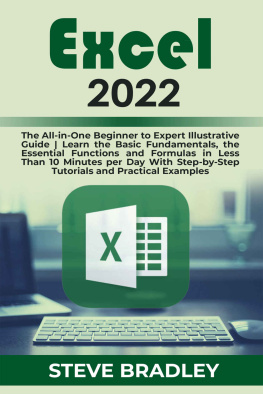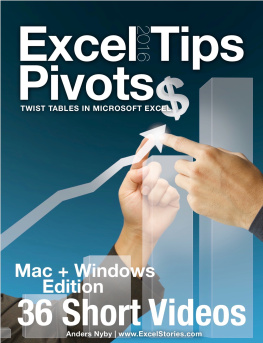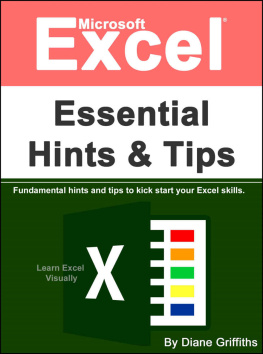Microsoft Excel Basic Tips
Primary hints and tips to kick start your Excel skills
K.M. KUMAR
Contents
Introduction
Setting up your Spreadsheet
Getting data into Excel
Formatting your spreadsheet
Display Management
Printing and sharing
Bonus - Make it Idiot Proof Bonus - A Summary of my Favourite Shortcuts Conclusion
Introduction
Dominate first showed up in the 1980s anyway bookkeeping pages have been about since the 1960s, some of you may recollect Lotus 123 and maybe a couple of you may have known about VisiCalc. In the mid-1990s Lotus 123 was extremely well known, I utilized it myself. Anyway, during the 1980s, Microsoft dispatched Excel which turned into the famous accounting page that we as a whole use today. Dominate experienced numerous forms and I recall many of them, I recollect that the 2007 variant caused somewhat of a complaint by presenting a strip as opposed to basic drop-down menus and toolbars. Many individuals didn't generally concur with the lace, yet I cherished it straight-away it's considerably more visual. At that point 2010 and 2013 Excel came out, which are fundamentally the same as however have some new highlights and upgrades.
Which version do I have?
You can either go to 'help' in your menu bar or if you don't have a 'help' go-to 'Document' > 'help' and you ought to have the option to see the adaptation.
All through this book when I take you through models I will talk through the 2010 form of Excel. Anyway from 2007 onwards the area of the vast majority of the users will be fundamentally the same as so ideally you will at present have the option to follow the means regardless of whether you don't have the 2010 rendition of Excel.
Main File formats
There are many distinctive Excel record arranges, the underneath is the ones I regularly need to manage:
.xls - the Excel 97-2003 exercise manual configuration .xlsx - the Excel 2007+ exercise manual configuration
.xlsm - the Excel full scale empowered organization you can tell whether an Excel document has a full scale (progressed programming) in light of its record design.
Dominate 97-2003 won't have the option to open the .xlsx design. So if you are utilizing an old rendition of Excel, check the organization on the off chance that you are experiencing difficulty opening it.
If you don't know which design a specific record is in you can right-click that document inside Windows Explorer and snap 'Properties'. Under the 'General' tab, you will see 'Sort of record:' this will disclose to you which document design you are working with, for instance, 'Microsoft Excel Worksheet (.xlsx)'.
Dominate 2007+ can open any of the above organizations and generally you'll likely be working with .xlsx.
Quick Glossary
The greater part of you will as of now comprehend the fundamental components of Excel however I need to utilize this segment to explain some key Excel wording to guarantee we are on the same wavelength.
Menu = The rundown of things along with the highest point of the screen; for instance, record, embed, page format, and so on
Ribbon = Ribbon resembles an extended menu. It portrays all the highlights of Excel in a straightforward pictorial structure. Since Excel has 1000s of highlights, they are gathered into a few strips. For instance, the 'embed' lace has capacities assembled into; clipboard, textual style, arrangement, number, styles, and so forth
Name box = Just underneath the Ribbon you have a white box on the left-hand side it shows the cell reference (default A1) or if you have indicated a name for a cell or scope of cells, it will show that name.
Formula bar = Next to the Name box, additionally underneath the Ribbon. The equation bar shows you the substance of a chose cell, especially helpful on the off chance that you need to see a count inside a cell and not simply the yield of the computation.
Spreadsheet = A technique for spreading data over a piece of paper - the screen speaks to a bit of paper with network lines.
Workbook = the document you make in Excel.
Worksheet = A page inside the Workbook. As a matter of course an Excel Workbook contains 3 worksheets; they are seen utilizing tabs along the base.
Cells = The framework lines make rectangular boxes - known as cells.
Alluded to as a letter and a number.
Columns = Cells down an accounting page are sections - letters.
Rows = Cells over the accounting page are lines - numbers.
First TIP! In your strips under a portion of the gatherings or segments, you have a little symbol that has two lines and a bolt.
While you can see a portion of the mainstream usefulness in the strip, if you click on these little symbols they will take you to a full rundown of accessible usefulness inside that segment.
Setting up your spreadsheet
There is no standard arrangement of decides to guarantee that you fabricate the 'great' bookkeeping page. Anyway, there are sure rules that you can continue to make a structure of best practice to accomplish a great bookkeeping page plan.
Purpose
The principal thing you have to know is the motivation behind your bookkeeping page. This assumes a vital part in how to plan and create it.
Start by understanding what your yields should be. What do you have to escape your accounting page? Do you simply need to catch and track information, or do you have to catch it so you can do certain estimations or give reports?
I discover it assists with working in reverse; guarantee you are clear about the motivation behind the accounting page, think about the yields and hence what coherent data sources you need to accomplish those yields.
How about we venture through the cycle.
1 - Define
You ought to have the option to characterize the reason for the accounting page in one sentence or less. This sounds rather evident and at minimal essential yet attempt it. On the off chance that you can't mention to somebody what the reason for an accounting page is in one
sentence or less, at that point, I would address what you are doing with it. Specifically, look out for attempting to do a lot with a bookkeeping page - one accounting page ought not and won't settle everything.
A case of an accounting page reason could be:
To capture weekly timesheet information for team A and produce a weekly summary report.
To provide summarised management information on the sales for Site X in Jan.
You ought to likewise guarantee that the accounting page is as clear as crystal as could be expected under the circumstances. Somebody ought to have the option to get this bookkeeping page in a year and have the option to comprehend what the accounting page is for, what it is letting them know, and how to utilize it.
2 - Consider what inputs you want and what inputs you have.
As a dependable guideline, it's smarter to have more information than you need. You can bar information effectively however it's difficult to get information, especially exact information, added in at a later stage.
There may be a hole between what inputs you have and what inputs you need to accomplish your necessary yields. Be sensible here. Would you be able to get to that additional information you require or do you have to change the reason for the bookkeeping page?
At long last, consistently state what your information source is, preferably with a date stamp of when the information was caught. I'll show you a few different ways you can archive this later.












